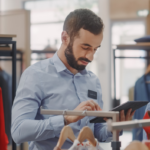Budget constraints and increasingly dispersed work forces continue to pressure organizations to move their training and education services to digital or online platforms. And many organizations have already shifted to more online delivery but for some organizations this shift has created a trap. It has polarized the delivery of education between digital and live in class where organizations tend to deliver learning in the form of one or the other.
However, what we are seeing from learners is a desire to integrate both digital and non-digital media, methods and activities in single events to enhance the learning experience. It isn’t enough to simply offer one or the other. Today, the experience needs to be a true blend, not just at the program level with multiple learning events, but within specific learning events.
Digital and Live: Not Mutually Exclusive
There is an effective starting point for shattering the dichotomy and it begins with recognizing that digital and live delivery are not mutually exclusive. Organizations now have the tools to purposefully integrate live and digital learning more effectively in single learning events.
The term “blended” captures this point but most blended learning programs today are simply a sequence of separate live or digital learning events. Their level of sophistication and scope is limited. To create a truly blended experience, organizations must integrate the two more completely.
With the tools at their disposal today, such as video, voice recognition and artificial intelligence, organizations can design and deliver programs using a purposeful synthesis of digital and non-digital tools designed to optimize the learning experience. Video is a leading tool in the learning space, but it continues to be used more frequently in self-directed online learning. According to Think with Google, YouTube users are three times more likely to watch a YouTube tutorial video than read an instruction manual. In the past year, 70 per cent of millennial YouTube users watched to learn how to do something new or learn more about something they’re interested in. It’s hard to deny, video has become one of the most popular learning tools in the 21st century.
Video’s prevalence in online learning doesn’t do it the justice it deserves as a learning tool. Yes, it’s critical to online learning, but it can offer even more value when you integrate it with live learning. In the classroom, video can be an educator’s leading digital tool. One of the many examples is video-based roleplays, which are proving to be wildly impactful in comparison with traditional roleplay setups. When participants use video, they are more likely to be engaged and are typically more critical of their performance. Consequently, they are more eager to give it another try. Another example of using video is in practising a presentation, which provides learners with the “instant-replay” of their performance allowing them to observe their own presentation step by step, slide by slide or point by point.
Recording individual takeaways, key learnings and visuals like flip-chart demonstrations or whiteboard illustrations from the classroom is another example of how to effectively use video in the classroom. It enables learners to create their own learning content for which they can access after the session. Educators can also take the lead in capturing the session highlights for participants to takeaway or upload into a learning management system. This is certainly becoming more prevalent, but in most cases, very little post-production effort is invested, which is a caution to educators. Educators are recording live lectures and video conference calls from beginning-to-end and simply posting it online. Today’s learner is expecting their content to be curated, cut up and stitched back in a way that delivers a richer learning experience that doesn’t start a video with “Ok, so let’s just wait for everyone to sign-in before we start.”
Being truly blended means setting out to create more sophisticated and purposeful integration that enables learners to engage with digital tools in live environments and vice-versa.
To the future learner, online and offline, digital and live will be the new norm and what remains is the measure of their learning experience. As organizations re-shape their learning solutions, they should be mindful that their commitment to blended is to truly combine media to enhance both the in-class and online experience.
*
The Schulich ExecEd has a dedicated design team ready and available to tailor and design programs and services that meet the employee training program needs of your business. For more information on Schulich ExecEd’s Offerings for Organizations, visit the Custom Team web page.














